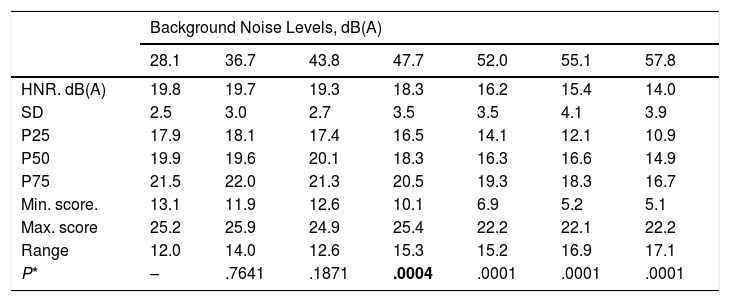Acoustic analysis is a tool widely used by professionals related to the study of voice that gives us information from a recording. It has been identified that in investigations carried out today that involve acoustic analysis, the recording process takes place in rooms with different levels of background noise. The objective of this study is to establish whether the acoustic parameter, Harmonic to Noise Ratio (HNR) varies in relation to the different background noise levels of the premises where the recording is made and recommend a maximum level of background noise.
MethodsThrough the Praat programme, the average value of the acoustic parameter HNR of 43 subjects was obtained, inside the audiometric booth of the Universidad Autónoma de Chile, whose background noise level is 28.1 dB (A) and it was compared with the HNR average values obtained with higher background noise levels.
ResultsThe HNR average values decreased from 19.8 dB (A) to 14.0 dB (A) as the background noise level of the premises increased from 28.1 dB (A) to 57.8 dB (A). The t-test for dependent samples was performed, with which the HNR average values obtained were compared with the baseline background noise level (28.1 dB (A)). Significant differences were found with the baseline background noise level when the room noise level was higher than 47.7 dB (A).
ConclusionsThe background noise of the premises where the voice recording for the acoustic analysis is performed, influences the value of the acoustic parameter HNR, which decreases as the background noise of the premises increases. It is recommended that the background noise level should not exceed 43.8 dB (A).
El análisis acústico es una herramienta muy utilizada por los profesionales afines al estudio de la voz que permite obtener información de ella a partir de una grabación. Se ha identificado que en las investigaciones que se realizan hoy en día que involucren análisis acústico, se realiza el proceso de grabación en recintos con distintos niveles de ruido de fondo. El objetivo de este estudio es determinar si el parámetro acústico Harmonic to Noise Ratio (HNR) varía en relación con los distintos niveles de ruido de fondo del recinto donde se realiza la grabación y determinar un valor máximo recomendado de ruido de fondo para esta sala.
MétodosA través del programa Praat se obtuvo el valor promedio del parámetro acústico HNR de 43 sujetos, al interior de la cabina Audiométrica de la Universidad Autónoma de Chile cuyo nivel de ruido de fondo es de 28,1 dB(A) y se comparó con los valores promedio de HNR obtenidos con niveles de ruido de fondo superiores.
ResultadosLos valores promedios de HNR fueron disminuyendo desde 19,8 dB(A) a 14,0 dB(A) a medida que el nivel de ruido de fondo del recinto aumentaba de 28,1 dB(A) a 57,8 dB(A). Se realizó la prueba t para muestras dependientes, con la cual se comparó los valores de HNR promedio obtenidos con el nivel de ruido de fondo basal (28,1 dB(A)). Se encontraron diferencias significativas con el nivel de ruido de fondo basal cuando el nivel de ruido de fondo de la sala era superior a 47,7 dB(A).
ConclusionesEl ruido de fondo del recinto donde se realiza la grabación de voz necesaria para el análisis acústico influye en el valor del parámetro acústico HNR el cual desciende a medida que el ruido de fondo del recinto aumenta. Se establece como valor máximo recomendado un nivel de ruido de fondo que no supere los 43,8 dB(A).






